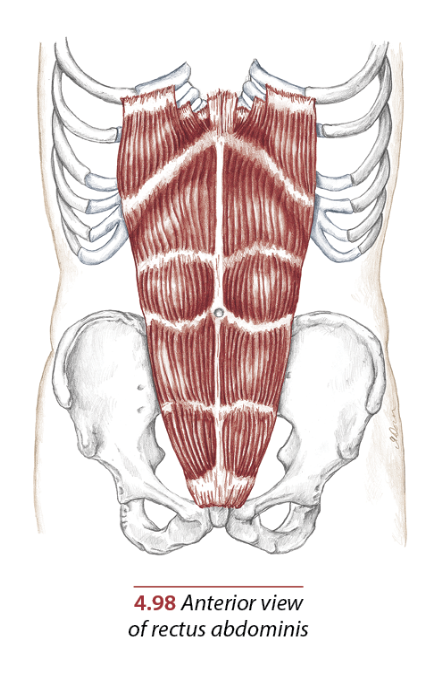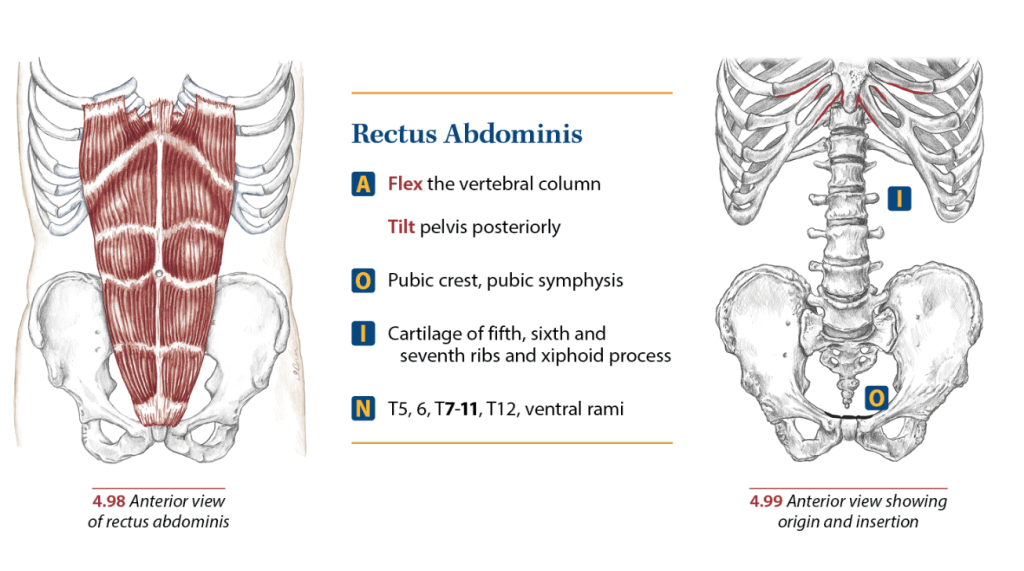
The rectus abdominis (RA) is known as the “six-pack” muscle. Most people know where the RA is but not everyone understands the intricacies of this muscle. Understanding RA beyond its basic location and mainstream function help personal trainers avoid injuries and dysfunction in the core muscle region.
Let’s take a closer look at rectus abdominus.
Rectus Abdominis Location
Use these directions to find the attachment points on yourself and connect to where rectus abdominis attaches. Lay supine on a table or mat and initiate what would be a crunch while you palpate the origin and insertion of the muscle.

Origin: Pubic symphysis of pelvic crest.
- Find the middle of your pubic bone.
- You can locate belly button first and follow the soft tummy tissue down until you hit the pubic bone.
- The pubic symphysis is cartilage that connects the right and left hip bones.
Insertion: Cartilage of ribs 5,6,7 and xiphoid process.
- Find the opening of your ribs, just below the sternum.
- The xiphoid points downward like an incisor tooth.
- Ribs 5,6,7 and their cartilage are directly below (inferior) the xiphoid on either side.
Rectus Abdominis Action
- Flexes the spine
- Laterally side bends the spine
- Slight rotation of the spine (may mostly return from a rotation back to neutral)
To explore these actions, identify the origin sites of rectus abdominis again and perform each action independently. You’ll feel the muscle tighten under your fingers as you move.
If you perform all three of these actions simultaneously rectus abdominus may feel like it’s contracting more strongly and completely.
Rectus Abdominis Exercises
Any exercise that requires contraction of one of the actions mentioned above will recruit the rectus abdominis into action. Synergistic muscles will also contract simultaneously. If you do an exercise combining all three RA actions it maximizes the potential for RA to contract.
- Stability Ball Crunches
- Plank – forearms or hands
- Bicycle Crunches
Unexpected Activations
While spinal flexion is the most obvious way to challenge the RA, research indicates that compound strength movements recruit RA fibers to a greater degree than even crunches; in an effort to prevent flexion, RA fibers must fire with maximal effort when heavy resistance is working against the spine.
Rectus Abdominis Stretches
To stretch the rectus abdominis, perform the opposite movements of its action. For maximal stretch perform all of the antagonistic motions together. If stretches cause too much discomfort, do one reverse action at a time. If there is pain when stretching – for you or your clients, consult with a physician.
Antagonistic (opposite) actions for stretching
- Extend the spine
- Laterally side bend the spine to the opposite side you want to stretch
- Rotate the spine
Try these stretches
- Cobra pose – laying supine, arch the spine up slowly and gently until a stretch is felt
- Side bend – while standing or kneeling, slide one hand down the same side thigh to stretch, try not to collapse, bend like a flower stem – gently
- Seated twist – sit on the floor and slowly twist the entire spine as far as is comfortable
Rectus Abdominis Over-Training
It is common for people to overwork rectus abdominis on a quest for six-pack abs. At the worst, this can lead to a hernia or compression of the abdominal organs. Training all core muscles equally and allowing them as much relaxation as training is important to maintain healthy posture.
Teach clients to contract AND relax the rectus abdominis.
Rectus abdominis is a popular muscle to exercise. Identifying the attachments of origin and insertion and understanding antagonistic movements enhances body awareness, which can increase performance and decrease the risk of injury.
References
Abrahams, P.H. et al. 2003. McMinn’s Color Atlas of Human Anatomy. London: Elseiver.
Muscolino, Joseph E. 2004. Musculoskeletal Anatomy Coloring Book. Philadelphia, PA: Mosby, Inc.







